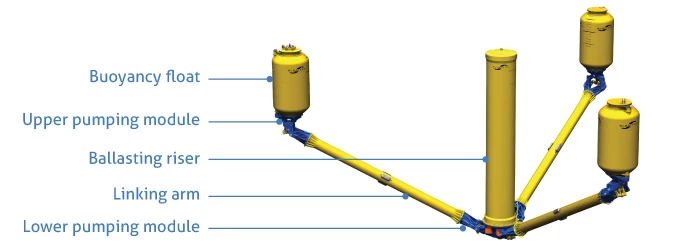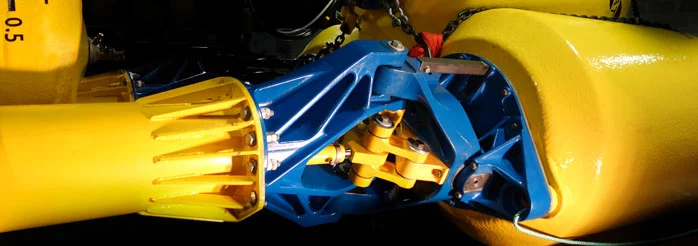Scotland's Albatern is putting a new, modular spin on renewable energy generation. WaveNET is a scalable array of floating "Squid" generator units that harvest wave energy as their buoyant arms rise and fall with the motion of the waves. Each Squid can link up to as many as three others, effectively creating a large, floating grid that's flexible in every direction. The bigger this grid gets, the more efficient it becomes at harvesting energy, and the more different wave movements it can extract energy from. Albatern's 10-year target is to have 1.25 kilometer-long floating energy farms pumping out as much as 100 megawatts by 2024.
How it works
Each Squid unit in the WaveNET array consists of a central ballast pole, surrounded by three buoyant floats that connect to the central post with linking arms. The linking arms connect to the central post with a fully articulating pump unit at each end, thus any movement of the arms as the floats move in the water causes those pumps to create hydraulic energy.

The Squid units can be connected to one another at the floatation points, and Albatern has discovered that building a large array gives you "dramatic non-linear yield improvements."
Imagine a blanket of points floating on the surface of the sea – as a wave travels through the blanket, those points are pushed together, pulled apart and moved individually along X, Y and Z axes relative to one another – and every time those points move, they're generating energy.

Using a common hydrostatic transmission system, the hydraulic energy pumped through all these units is gathered at a central point and converted into electrical energy through a "power take-off" module, and here the electricity can be transmitted to shore.
Unique advantages
Because the WaveNET system is set up as an array, it's able to extract energy from five of the six degrees of wave movement – pitch, roll, heave, surge and sway.Because it's flexible and connected to the ocean floor at multiple points, it's resistant to damage from large waves because some or all of the array can be fully submerged without issue.
And because most of the action takes place underwater, the only visual impact of a WaveNET array is a group of floating yellow buoys, not unlike a mussel farm.

Scaling up
Each individual Squid unit in current WaveNET testing off the Scottish coast has a 6 meter (20 ft) tall central ballast pole, and has a generating capacity of 7.5 kW. Next up will come a 12-metre version with a 75 kW capacity, followed by a giant 24-metre Squid that can generate up to 750 kW.


Albatern says it can build a 100-megawatt WaveNET generator within ten years using an array of 135 of the 24-metre units, with a 1250 x 250 meter total area (4101 x 820 ft). Cost of energy is estimated at £100-150 (US$160 - $235) per MWh, which is higher than other renewable energy sources such as solar and wind at this stage.
Albatern sees its immediate market in offshore businesses – oil rigs, aquaculture outfits and remote communities that are close to rough seas but far from other sources of power. But its eventual goal is to operate large grid-scale operations within the next 10 years.
Source: Albatern WaveNET.























